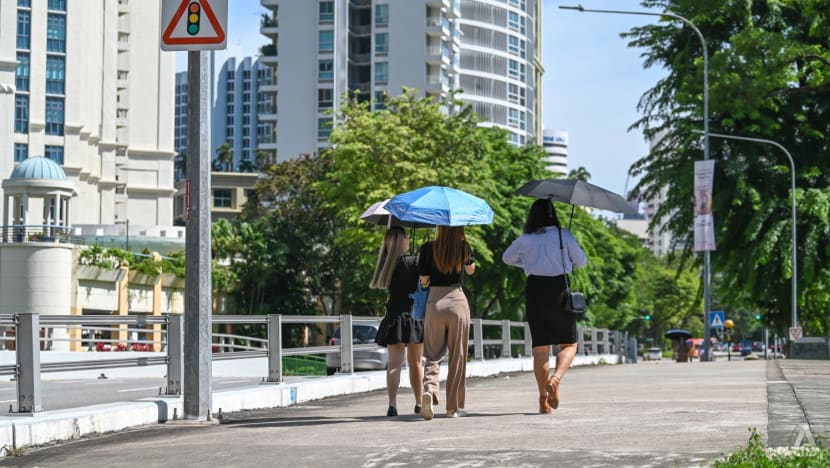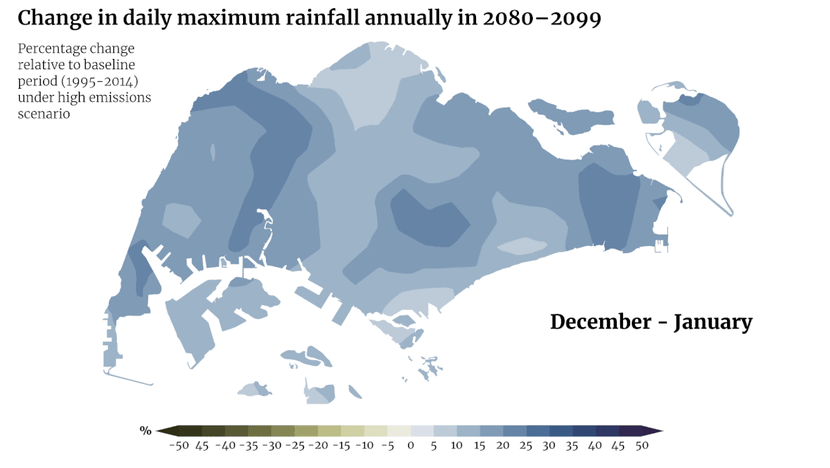Feeling hot, more often? More days of extreme heat predicted in National Climate Change Study
Days with temperatures exceeding 35 deg Celsius will likely double by the end of the century, even for the most optimistic scenario outlined in Singapore's latest national study on climate change.

People with umbrellas in Singapore on Nov 22, 2022. (File photo: CNA/Hanidah Amin)

This audio is generated by an AI tool.
- More very hot days, where temperatures exceed 35 deg Celsius, are projected by end-century
- Warm nights, where temperatures are equal to or exceed 26.3 deg Celsius will be felt for most of the year by end-century
- Correspondingly, the number of days with incidences of high heat stress will spike towards the end of the century
- Heavier rain, and more frequent and longer dry spells are also expected
SINGAPORE: Imagine living in a Singapore where the heat is both unbearable and a potential threat to your health on most days, and where night-time temperatures rarely fall below 26.3 deg Celsius.
More very hot days are expected as Singapore nears the end of the century - even if the world takes a path of sustainable growth.
Updated projections from the third National Climate Change Study, released on Friday (Jan 5), also predict more warm nights and more days with high heat stress.
"We expect that the impacts of heatwave events will cause a rise in Emergency Department visits among those at risk or currently suffering from heart attacks, chronic kidney disease and chronic obstructive pulmonary disease," said Assistant Professor Borame Dickens, when asked about health challenges in the face of very hot days over sustained periods.
"Those who are suffering from diabetes, obesity or hypertension will be at a higher risk of developing complications from the additional heat stress," said the Asst Prof from the National University of Singapore's Saw Swee Hock School of Public Health.
Tropical Singapore has already seen record warmer days in the past few years.
Temperatures matched a 40-year high in May when the daily maximum temperature hit 37 degrees Celsius in Ang Mo Kio. This was also the highest daily temperature for the month of May, breaking the previous record of 36.7 degrees Celsius at Admiralty in 2022.
The last 10 years, from 2013 to 2022, have been Singapore’s warmest decade on record.
The heat has spurred authorities to launch a new service to help people gauge heat stress risks while engaged in outdoor activities.
Apart from this, Singapore combats heat by increasing greenery in urban spaces or deploying cool paint to reduce heat absorption in buildings.
Singapore also employs design strategies - such as orienting buildings along a North-South direction to reduce heat gain - and is further using modelling and simulation to inform city planning.
All these will have to be further improved to deal with climbing temperatures.
Illustrating how life may look for Singaporeans in the future, Professor Winston Chow said: "For instance, young schoolchildren will likely have to adapt their behaviour to avoid spending time outdoors, or have school uniform policy changed to reduce thermal discomfort."
Those who work outdoors, even if physically fit, face higher levels of risk of heat illness if they do not adapt to the expected warmer days, added the Singapore Management University's professor of urban climate.
Asst Prof Dickens said: "Day to day public engagement and communication from the government is key, alongside the long-term need for heat-resilient urban infrastructure."
Encouraging the population to become more adaptive to heat and to understand warning signs of heat stress; and then quickly reacting, could help many avoid needing emergency medical attention, she added.
That said, Prof Chow believes other sectors should be involved.
"How businesses and the private sector acknowledge a warmer world also enables successful adaptation, such as construction firms consistently applying the heat safety measures to ensure their worker safety, or workplaces that alter their dress codes to suit a warmer climate ... based on version three's findings.
"To me, this is just as important as 'better' governmental policies to reach this particular end."
Warmer temperatures here are consistent with other parts of the globe.
"Globally, the years 2015 to 2022 were the eight warmest in the 173-year instrumental record," noted the National Environment Agency's chief executive officer Wong Kang Jet in the foreword of the study's stakeholder report.
WARMER TEMPERATURES, MORE DAYS OF HIGH HEAT STRESS
The National Climate Change Study produces results based on three global warming scenarios of low, moderate and high carbon emissions.
Consistent with earlier projections, Singapore is expected to become warmer in all scenarios, with annual mean temperatures rising between 0.6 deg Celsius and 5 deg Celsius by end-century.
While Singapore’s annual mean temperatures increased at a rate of 0.24 deg Celsius per decade in the past 40 years, this is likely to rise to 0.55 deg Celsius per decade by end-century, under the high emissions scenario.
Across all three scenarios, the mean maximum daily temperature will rise to between 31.9 deg Celsius and 36.7 deg Celsius by end-century.
The number of days where daily maximum temperatures exceed 35 deg Celsius, also known as very hot days, will increase.
There were 21.4 days per year on average with such high temperatures in the last 40 years. By end-century, this will likely go up to between 41 and 351 days per year on average, across the three scenarios.
People are likely to feel warmer even at night, with the study projecting more nights where temperatures equal or exceed 26.3 deg Celsius.
Over the last 40 years, Singapore had an average of 76 such nights per year. By 2100, there will be at least 312 warm nights annually.
Under the high emissions scenario, every night will be warm.
Coupled with Singapore's urban heat island effect, temperatures in urban areas could be 1 to 2 deg Celsius hotter during the day, compared to greener places, noted Asst Prof Dickens.
"Singapore will continue to develop more urban infrastructure so the problem may worsen in the future, although there is now significant work ongoing to help Singapore become a more heat-resilient city."
Prof Chow's work on Cooling Singapore - a project that develops solutions to address urban heat in the country - will be using data from this third version of the national study to account for the urban heat island effect.
"It’s very likely that night-time temperatures projected by version three will increase once the urban heat island effect is accounted for; this will have implications for thermal discomfort issues for Singapore residents at night ... as well as residential air-conditioning use that may increase Singapore greenhouse gas emissions."
MORE HEAT STRESS
Singaporeans will also be at higher risk of heat stress as temperatures rise, according to data from the study. Heat stress is when a person's body is unable to cool itself sufficiently and is damaged.
The stakeholder report details the range of annual average daily mean wet bulb globe temperatures across the three scenarios, within the same time period.
Wet bulb globe temperature is an indicator that reflects the main environmental factors contributing to heat stress, such as air temperature, humidity, wind speed and solar radiation.
Days of high heat stress occur when wet bulb globe temperatures equal or exceed 33 deg Celsius.
According to the study, more days with an incidence of high heat stress are expected.
Singapore currently sees a maximum annual occurrence of eight days of high heat stress. This will increase to between 54 and 326 days annually across the three scenarios, by end-century.
Children, the elderly and those with health conditions will be at greater risk of complications associated with heat stress.
Announcements of advisories for these vulnerable groups would be expected, should very hot days become the norm, according to Asst Prof Dickens.
"These advisories and warnings could inform the public to avoid areas that may be challenging to keep cool, including outdoor hawker centres and parks. Depending on the severity of the heat, either groups at higher risks of having complications or even everyone may be strongly recommended to take action to avoid the heat."
The experts' advice to the average Singaporean is to adapt to mounting temperatures by altering their behaviour.
For Prof Chow, this includes dressing appropriately; being informed and educated about the signs of heat stress and reacting accordingly by seeking shelter and drinking fluids; and being in tune with heat advisories.
Asst Prof Dickens' advice includes doing outdoor activities early in the morning or evening when it is cooler, and to be aware of what your body tells you.
On the scientific end, researchers like Asst Prof Dickens are working on mathematical models that can look at how future temperature projections will impact chronic disease burdens and emergency department visits.
The Daily Cuts: What a hotter Singapore means
WET MONTHS GET WETTER, DRY MONTHS DRIER
Apart from warm weather, the study also projects wet and dry weather extremes.
Singapore sees a total annual rainfall of around 2500mm, with eastern parts receiving less rainfall compared to other parts. The island's rainfall is highly variable at seasonal time scales.
"Projected end-century changes in average annual rainfall totals are strongly dependent on the emissions scenario used. For the medium and high emissions scenarios, the projected changes could either be negative or positive," the stakeholder report noted.
Under the low emissions scenario, for average seasonal rainfall totals, the wet months of December to January are expected to get wetter by up to 58 per cent by end-century.
Under the high emissions scenario, the dry months of June through September are expected to get drier by up to 42 per cent.
By the end of the century, total rainfall during the southwest monsoon dry season of June through August could fall significantly below the historical low of 314mm - recorded in 1997 - around once every three years.
For the northeast monsoon wet season of November through January, the corresponding seasonal total rainfall is projected to exceed the historical high of 1507mm - recorded in 2006 - occasionally.
Extreme daily rainfall is projected to increase across all seasons and scenarios, with increases ranging from 6 to 92 per cent in the inter-monsoon months of April and May under the high emissions scenario.

Even then, more frequent and longer dry spells are expected. A dry spell is an episode of at least 15 consecutive days with islandwide rainfall of less than 1mm each day.
Singapore is expected to experience on average one dry spell every ten to 60 months, by 2100.
Under the high emissions scenario, one dry spell will happen every 10 months on average, with a maximum duration of around three weeks, by the end of the century.
Wind speeds are also expected to increase by end-century. Overall, 10m wind speeds are expected to increase by up to around 6 per cent to 20 per cent during the northeast and southwest monsoon seasons, and by up to 6 per cent to 11 per cent in the inter-monsoon months of April and May.
Graphics by Clara Ho
Animated map by Rafa Estrada
Source: Meteorological Service Singapore, Centre for Climate Research Singapore



















